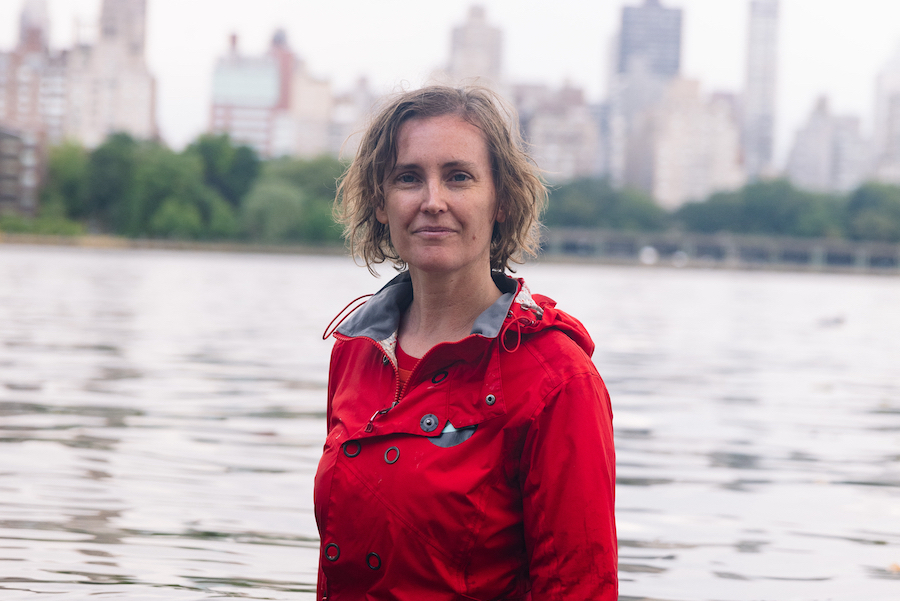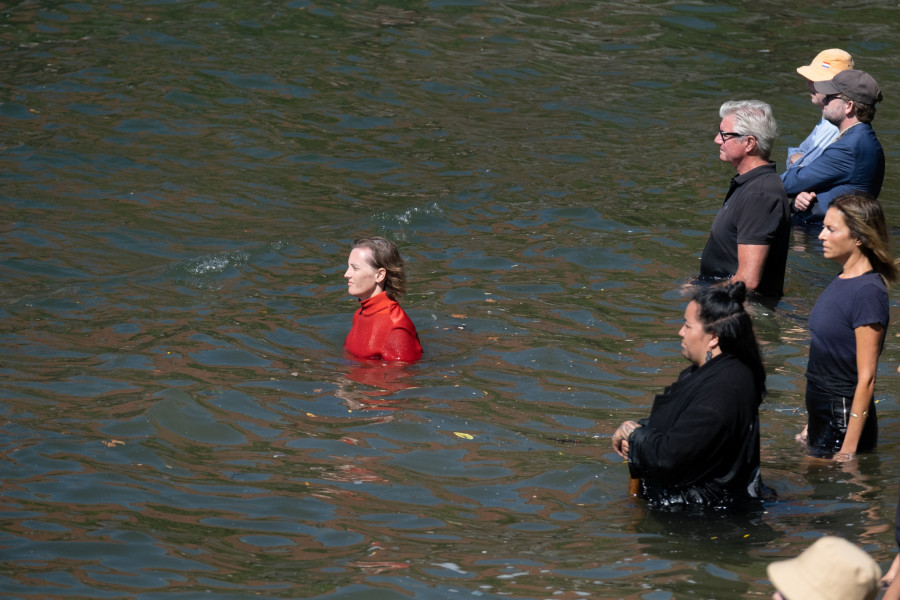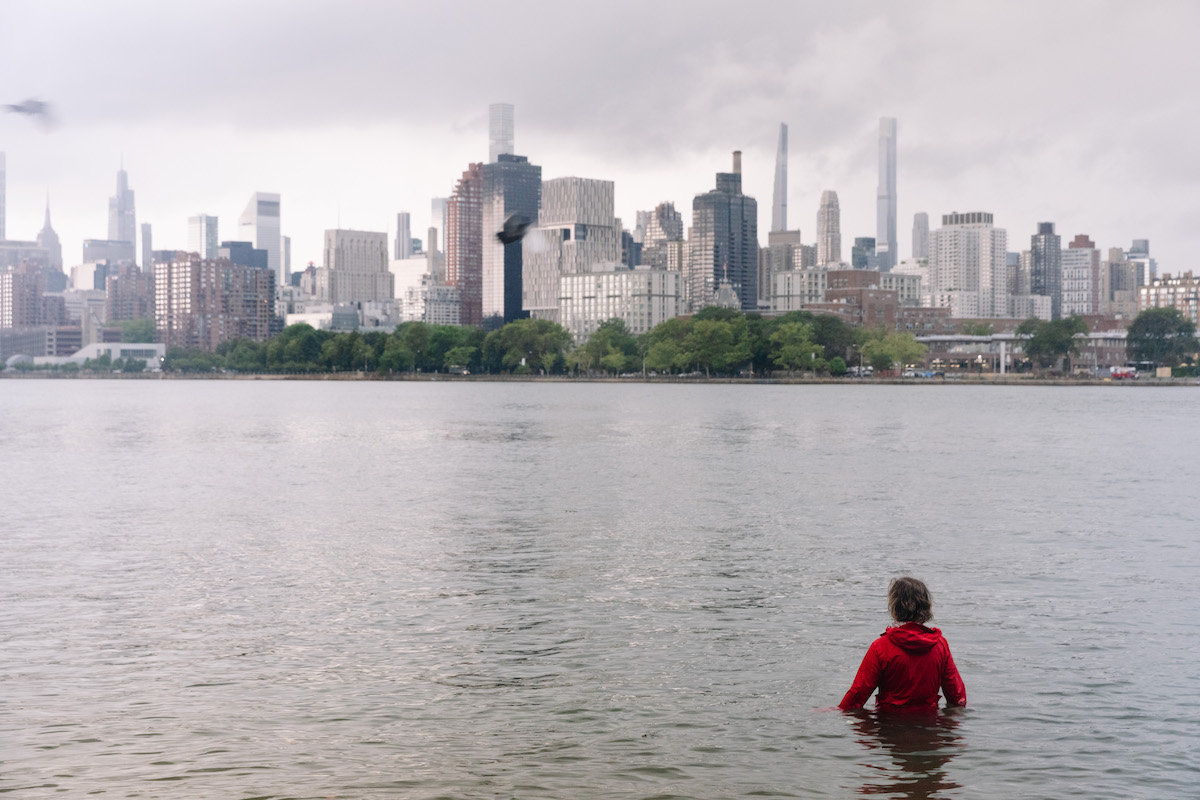Monaco Life, in partnership with the Princess Grace Foundation-USA, is proud to present a monthly series highlighting the lives and artistic work of the Princess Grace Foundation-USA’s illustrious Award winners.
In this month’s exclusive interview, Princess Grace Foundation-USA’s Chief Program Officer Diana Kemppainen catches up with Princess Grace Award winner Sarah Cameron Sunde (2005, Theatre). Sarah is an environmental interdisciplinary artist and director working at the intersection of performance, video and public art.
In 2022 she completed her series, 36.5/A Durational Performance with the Sea for which she received the prestigious Guggenheim Fellowship. Her largest series to date, 36.5/A Durational Performance with the Sea took place in nine locations across six continents, in which Sarah stands in a tidal area for a full cycle (12-13 hours) as the water engulfs her body and reveals it again. What began as a poetic response to New York City’s Hurricane Sandy and the struggle of humanity to survive in the face of sea-level rise has grown into a complex evolving series of nine artworks, involving thousands of people in communities around the world. As an artist and environmental activist, Sarah has presented her work at the United Nations, courtesy of Isabelle Picco, Ambassador, Permanent Representative of Monaco to the United Nations and The World Economic Forum in Davos.
In celebration of Earth Day, Sarah spoke to Diana about 36.5/A Durational Performance with the Sea, how she engages local communities in her art, and how art and environmental activism can work together to spark meaningful conversation around climate change.

Let’s start at the beginning. What inspired you to become an artist?
Sarah Cameron Sunde: Since I was very small, I have always loved to make things. I remember having artistic experiences as a young person and I’m sure those experiences inspired me in ways I can’t articulate now. I went to elementary school in the Bay Area in California and there was a farm. We took care of the animals and were encouraged to think outside of the box with every project that we did. So, I understood from a very young age that I thrive in creative environments. I also remember learning that the mother of a friend was an artist and it made an impression on me. Perhaps this was the first time I understood that I, too, could choose to be an artist – that it was a possible path in life. So educational experiences, encouragement from my parents, and exposure to the arts and adults who were artists that inspired me.
36.5: A Duration Performance with the Sea is a series of works that spanned almost a decade. Tell us about the genesis of the work?
It all began when Hurricane Sandy hit New York City in October 2012. I was struck by the vulnerability of our city and realized that it was entirely possible that my beloved home could disappear in my lifetime, due to the climate crisis, extreme weather events, and sea-level rise. As New Yorkers, we tend to forget that we are surrounded by water and this water is powerful. I had been working on another project at the time, examining the cliché and reality of a struggling artist and it hit me like a ton of bricks — there was a parallel between individuals struggling to survive on a daily basis and the struggle of humanity to survive in the face of the sea-level rise.
So I started working to articulate this scaled parallel through my work. And nine months after Hurricane Sandy, in August 2013, I was on the coast of Maine and the daily tidal shift was so drastic that it changed the visuals of the place completely. I couldn’t stop watching. I realized that the tides could be a metaphor for environmental change – and I imagined a person standing in the water for a full tidal cycle, getting swallowed by the water and then the water leaving them bare. At first I thought maybe I could convince someone to execute this endurance performance and I could just direct/capture it. But I quickly realized that I would have to do it myself. Three days later, there I stood for 12 hours and 48 minutes. So, it was a hurricane, nine months of contemplating the ideas, and then one big “aha” moment that was the genesis, the beginning of this journey.
36.5: Durational Performance with the Sea seems to be part of a larger lifelong commitment to create work that reflects on the Anthropocene. What draws you to this work?
I’ve always cared deeply about the environment and natural world but it took me a long time to figure out how to pull this into my work. Before Hurricane Sandy, I made site-specific work in outdoor spaces, but I didn’t know how to address the ecological crisis effectively, without banging people over the head about it. It needed to be nuanced, complex, experiential. And I also didn’t know what I needed to say about the Anthropocene or climate change until I experienced an extreme weather event personally. After Hurricane Sandy hit New York, I understood the vulnerability of our species in my gut and this understanding has stayed with me ever since then. I think about Time as my primary material, and the climate crisis is by far the biggest conflict of our time, underlying everything we do as humans and having deep consequences for the more-than-human world. My relationship with water changed during that storm and that’s when I committed to making this the focus of all my work. Borrowing a phrase from my dear colleague/advisor/mentor Una Chaudhuri, I view everything through a climate lens now.

You traveled to the Netherlands, Bangladesh, Kenya, Aotearoa-New Zealand, Brazil, among other places for 36.5/ A Durational Performance with the Sea. How do you pick each place?
The first time I stood for a full tidal cycle in Maine, I understood in my body that I was connected to billions of people around the world who are dealing with the climate crisis on a daily basis. During that stand, I made a promise to myself that if I could survive this 12 hour, 46 minute cycle, this would be a series of works that I would create in collaboration with communities around the world in order to better understand what others were dealing with. I wanted to understand how those experiences connected to who we are as New Yorkers.
Choosing each location began with a combination of research — to find out where sea level rise is impacting communities most severely — and connections to people who live in that community. Of course, nearly every major city in the world will grapple with climate change and issues caused by sea level rise. So the choices of where to do the project emerged organically, based on who introduced me to someone who wanted me to come and collaborate.
In each of these places, the community is a critical component and you spend a significant amount of time with the communities. Can you talk about community work and its importance to your artistry?
Yes, I usually spent years preparing and at least 5 or 6 weeks on the ground in each place working with the people in these communities. My job was primarily to listen, and they influenced every choice I made with the work – from where exactly to stand, who to collaborate with, and what artistic interventions needed to happen. The only constant was the frame of my walking into/out of the water and the invitation to participate. Everything else was site-specific — what happened on the shore, the production team, how it was organised, and what happened. Each time was very different based on who I met.
For example, each performance included a “human clock” – brief performances that would occur every hour during the tidal cycle to mark the passage of time. In each location, I worked with community members to bring their culture and unique perspectives into these moments. In Brazil, the human clock was street poetry performances of resilience. In Bangladesh there was lots of music and some Bangla dancing. In the Netherlands, we had an opera singer. In Kenya, we had a town-crier and the village brought out their 400-year-old ceremonial drum. It became a different thing every time depending on who I happened to meet and it is through these connections where I learned the most as a person, as an artist, as a human.
This work is site-specific, and I couldn’t have done any of it without strong collaborators in each of these communities. Their understanding of place is absolutely critical to making this work.
Connection and collaboration across boundaries are an important part of all my work. I believe we can’t exist as individual silos. We have to find new ways of working together in order to survive the climate crisis. 36.5asks, how do we come together on this issue? How can we shift public consciousness on an individual scale, community scale, and on a global scale?
Art and activism often go hand in hand, and your work as an artist has brought you to the forefront of conversation around climate change. You’ve presented your work at the United Nations and at the World Economic Forum in Davos. What is the impact artists and their work can have in the larger conversation around sea level rising and climate change?
I think that artists are really critical to this conversation because there are so many people who don’t want to see a long list of depressing facts and statistics and don’t want to be told what to think about our changing climate. It’s still abstract and hard to comprehend for most people. Having art that addresses climate change without banging you over the head, but asks real questions, shares stories, and connects emotionally to be in your consciousness on a daily basis is really critical. We cannot turn away from this challenge. Art is what allows us to connect personally and hopefully stay with it.
As artists, we have to continue having this conversation with people outside of our niche artistic circles. It’s important for me to bring my work into larger policy and presentation spaces. I sometimes wonder if bringing my work to certain more formal, corporate settings takes away from the mission of it, or the community-based aspect of it, but I’ve realized that it’s really important for me (for us — me and the entire 36.5 global team) to be in conversation with policymakers and the people who have power to actually make large sweeping changes. I might not always agree with what they’re doing, but when I have an opportunity to share the work on some sort of political level, I feel like I have to say yes, because you never know when it could move somebody to feel something new and do something differently. And that’s it. That’s important. So it’s a very different audience. I would love to see more opportunities for artists to be an important part of the public discourse, not just as entertainment, but as the thinkers and the cultural leaders that we are.

Durational work is a physical challenge; for 36.5 you stand in the sea for a full tide cycle – 12-13 hours as the tide rises and falls. How do you prepare for this long form work, and what sustains you through the tide cycle?
Because I’m a conceptual artist, I’ve always found different ways to prepare, based on the site and the people I’m working with. I listen and follow instructions when they tell me to do something to prepare my body for performance. The most important thing is to be with the water.
The body water I’m performing with is my primary collaborator and so my preparation involves a lot of time at the shore, in the water, paying attention and listening. I don’t ever do a full tidal stand before the performance day, but I do many test stands for an hour or so, to figure out where to stand. It is a lot of mental preparation as well – Just getting to a point where I’m feeling ready to go for it, and that I can do it, no matter what happens or what goes wrong.
Part of the point of the performance is to live through the struggle, knowing it’s going to be hard. The struggle of the performance is itself a metaphor for the challenges that humans as a species will face in the climate crisis as we work to survive. I always hope that audiences and participants will take this in, and slow down enough to reimagine their own relationship with water.
What’s next for you?
Now that the nine performances are complete, I’m working on exhibiting the video artworks. I have six durational video artworks (12-13 hours each) and my goal is to have a large-scale 12-18 video channel exhibit that travels around the world and back to each location where the work was made. I’m also considering other forms — working on an archive, a documentary, a book, and staying in conversation with my international collaborators.
A few new projects are just beginning — a commission with a colleague to make a new work with the South River in Atlanta, another durational performance work that de-centers the human in relation to a large elm tree, and I’ve begun a conceptual work that attempts to ditch the mechanical clock and train my body to live on tidal time all of the time.
Any final words for the Monaco community?
Thanks for reading and for your interest in this work. The Princess Grace Foundation has played a vital role in my interdisciplinary artistic work, and I’m so grateful. Thanks to Ambassador Picco for coming out to the final performance in September, 36.5 / New York Estuary! Please don’t hesitate to reach out if you want to be involved, and I hope to share the video artworks with you in Monaco soon!
To learn more about Sarah and her work visit 36.5/A Durational Performance with the Sea and her website.
Feature photo credit: Jeremy Dennis
